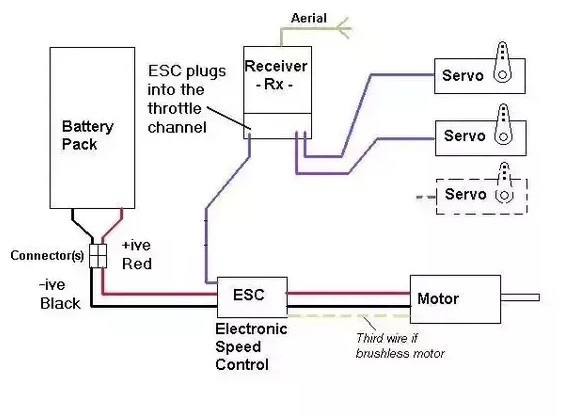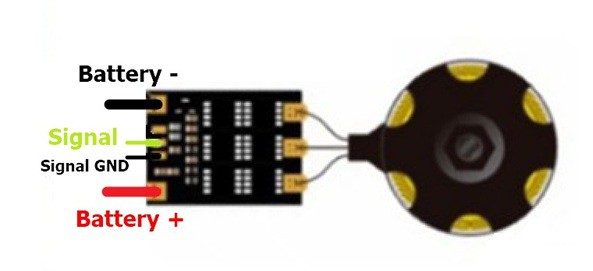Much like the drone’s propellers, motors, and the flight controller, another component that plays a huge role in allowing drone pilots to maneuver these flying machines with ease: the ESCs (Electronic Speed Controllers). These little circuit boards have been the center of attention of recent advances in drone technology.
ESC controls the speed of the motors in an FPV drone. The ESC receives throttle signals from the flight controller and drives the brushless motor at the desired speed. Using good quality ESC’s means you should have a reliable and smooth flight experience.

In this guide, you will get to know what exactly is an ESC, how do they work and the main considerations to keep in mind while buying an Esc for your drone.
What is an ESC?
An Electronic Speed Controller (ESC) is a device that regulates the power of an electric motor, allowing it to throttle from 0% to 100%. There are two styles of Electronic Speed Controller, Brushed and Brushless. Both work on the same principle.
An ESC is made up of three key components. A BEC/voltage regulator, a Processer and the switching consisting of FETs.
The BEC/voltage regulator is a division of the ESC that will send a set amount of power back to your receiver to then power your servos. This also has a secondary function whereby if the battery that is driving the motor reaches its minimum voltage the BEC will reserve power for the flight critical controls, making sure the motor doesn't take all the power from the battery.

The processor is an integrated circuit that now days is completely contained in a single silicone semiconductor chip. Its job is to translate the information being given to it from the receiver in the model and switch the FETs to regulate the power to the motor. The FET is the component that is doing all the work in an ESC. It "sees" the full voltage and current of the battery and motor. A FET is essentially an electronic switch that chops up the flow of electricity that in turn throttles the motor.
Working of ESC
The ESCs are frequently used on RC models which are electrically powered, with the change most frequently used for brushless motors basically providing an electronically produced 3-phase electric power low voltage source of energy for the motor.
An electronic speed control will have 3- sets of wires. One wire will plug into the main battery of an airplane. The second wire will have a typical servo wire that plugs into the receiver’s throttle channel.

Firstly the pilot transmit the signal from radio transmitter and that signal is received by radio receiver which is fixed at the Drone and then further that signal is sent to the Flight controller board which generates an Appropriate signal which is forward to the Electronic Speed Controller The ESC takes the signal from the flight controller and power from the battery and makes the motor spin according to the strength of signal of the Electronic Speed Controller that it received from the flight controller.
Connection of ESCs
ESC is powered directly by LiPo battery, and motor speed is controlled by a signal from the flight controller.
The motors are connected to the ESC through 3 wires. The wire order doesn’t actually matter. If the motor spins the wrong direction, simply swap any two wires.

Factors to Keep in Mind while Buying an ESC
In selecting an ESC, it is important to think about the main considerations. The considerations for ESC choice include:
- Motor size: The size of the motor will greatly dictate the amount of amperage your ESC must be able to handle.
- Propeller: Choice of propeller will also dictate what amp rating your ESC should be. The pitch of the propeller will determine how much high amperage ESC you would want
- Battery: Will you be using a 3 cell battery, or a 4, 5 battery. ESCs are rated for amperage, along with battery cells.
Selecting the right ESC is important so that the FETS on the ESC don’t become damaged from the amperage and fail mid-race. Therefore, it is a good idea to design your drone for your specific need and application. For a racing drone which requires 4-5 propellers and a 4S battery an ESC of 30 amp will work for applications like these.

The size and quality of these FETs determines how much current (amperage) can pass through the ESC. Most ESCs will have ratings such as ’30 amps’ or ’25 amps’. These numbers generally represent the sustained current the ESC can handle. The amp rating is an important consideration when purchasing an ESC. It is far better to get an ESC capable of more current, at the cost of size or expense. Larger motors tend to draw more current, and larger propellers, or propellers with a greater pitch will also draw more current.
ESCs are also rated at their ability to handle voltage. If voltage is increased, the pilot chooses to give more throttle, the amperage will increase and thus the total power of the motor will also increase. Thus higher the voltage higher is the speed and height at which the drones will fly.
Thus the Electronic Speed Controller is a very critical component situated between the flight controller, battery and the motor. There are a wide range of ESCs that can meet your needs of the type of drone you want to make. It is advisable to get an ESC capable of handling greater amps and voltage than you may plan to use. It is important to match the ESC with the style of flying and the intended application.
To explore a wide variety of ESCs of some of the famous brands at the best price Click Here.
Also if you want other components of drones like Cameras, Motors, Propellers, etc. with a wide variety of options at the best price Click Here.
 akanzler007
akanzler007
Discussions
Become a Hackaday.io Member
Create an account to leave a comment. Already have an account? Log In.